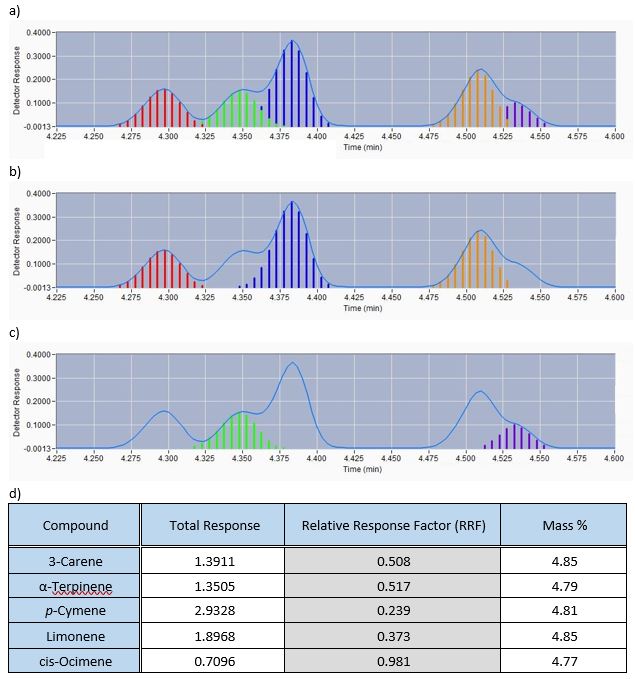Published Alex Hodgson on March 23, 2018
Automated Terpene Analysis Using VUV Analyze
Up until now, I’ve been presenting terpenes data to you using traditional methods, identifying peaks based on retention time and using an external calibration curve to obtain absolute quantitative data. However, there is another type of quantitation that is well utilized by VUV technology: time interval deconvolution (TID). We’ve previously demonstrated the power and speed of TID using the VUV Analyze PIONA+ software package, particularly in the analysis of gasoline with ASTM method D8071. Because essential oils are pure mixtures of known terpenes, we should be able to treat them much like a gasoline sample (another complex mixture of known compounds) and quickly determine a percent composition using TID.
What makes TID unique is that instead of specifying integration or other quantitation windows for individual analytes, the entire chromatogram is broken down into regular time intervals (for terpenes analysis, every 0.005 minutes). For each time interval, the absorbance spectrum is matched against the reference spectra in a given library, and the fit with the best analyte(s) is made. Because the spectral data behaves according to the Beer-Lambert Law, the measured absorbance spectrum is simply the sum of the individual analyte spectra, which makes resolving co-elutions straightforward (Figures 1a-c). This process is performed at every time interval in the specified time range, and the total contribution of each analyte is summed for a “total response” value. This value can then be weighted with a relative response factor, density, and external calibration curve to yield a relative mass percentage, relative volume percentage, and absolute concentration, respectively (Figure 1d). Thankfully all these algorithms happen under the hood, so all you need to do is load in your sample run and hit go!
Or in this case…

VUV Analyze now automates terpenes analysis. Data analysis is as simple as hitting the “Analyze” button to speciate terpene compounds and get results in mass or volume % as well as absolute concentrations.

Figure 1. Time interval deconvolution of co-eluting terpenes (a), most of which are isomers. From left to right: 3-carene (red), α-terpinene (green), p-cymene (blue), limonene (orange), and cis-ocimene (purple). Each vertical bar represents the fit of each analyte for a given time interval. As you can see in (b) and (c), when the co-eluting peaks are toggled off, the software still captures the full front and back of each peak, leading to more accurate quantitation. The table in (d) shows the quantitative output from VUV Analyze: in this standard run the analytes should be in equal concentrations, and indeed the data supports this.
Read more about GC-VUV analysis of terpenes.
Learn more about how GC-VUV simplifies flavor and flavors applications.










Leave a Reply